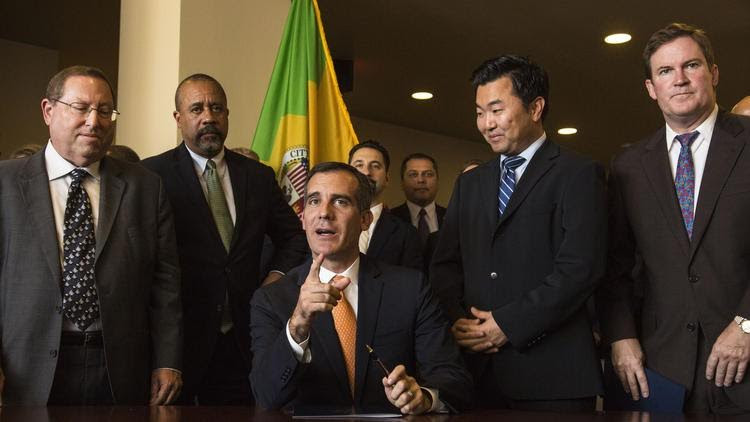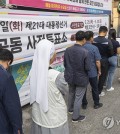- California Assembly OKs highest minimum wage in nation
- S. Korea unveils first graphic cigarette warnings
- US joins with South Korea, Japan in bid to deter North Korea
- LPGA golfer Chun In-gee finally back in action
- S. Korea won’t be top seed in final World Cup qualification round
- US men’s soccer misses 2nd straight Olympics
- US back on track in qualifying with 4-0 win over Guatemala
- High-intensity workout injuries spawn cottage industry
- CDC expands range of Zika mosquitoes into parts of Northeast
- Who knew? ‘The Walking Dead’ is helping families connect
Councilman Ryu teams up with Mayor Garcetti as El Niño approaches LA

Los Angeles Mayor Eric Garcetti (sitting) speaks to reporters as Councilman David Ryu (right) listens. (Courtesy of David Ryu staff)
By Brian Han
It’s widely known that California is in dire need of water. Soon it might have to deal with the problem of getting too much at once.
Los Angeles Councilman David Ryu joined Mayor Eric Garcetti and Councilman Paul Koretz to begin preparations for what NASA Climatologist Bill Patzert calls “Godzilla El Niño.”
“The strengthening El Niño in the Pacific Ocean has the potential to become one of the most powerful on record, as warming ocean waters surge toward the Americas, setting up a pattern that could bring once-in-a-generation storms this winter to drought-parched California,” wrote Los Angeles Times reporter Rong Gong Lin.
The biggest threats to local communities go beyond just potential flooding.
“It is equally important that the hillside communities in my district and other areas subject to flooding, mudslides, and debris are provided the necessary information as they prepare for the anticipated El Niño storms,” wrote Ryu in his most recent newsletter.
All 13 city departments will be in close communication with both each other and residents as the storm approaches the county.
In other news, Ryu completed his first one hundred days back on Oct. 11 and reflected on his accomplishments so far.
He listed out priorities that he mentioned during his campaign including “restoring trust in local government,” “reserving residential neighborhoods.” “fighting for fiscal responsibility,” “advocating for neighborhood infrastucture improvements,” prioritizing community engagement and input,” and finally “promoting public health safety.”
He goes on to elaborate exactly how he determines his success with specific examples, which the public can read here.
















